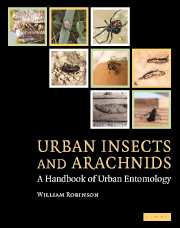Book contents
- Frontmatter
- Contents
- Preface
- Part I Urban entomology
- Part II Insects in the urban environment
- 4 Blattaria
- 5 Coleoptera
- 6 Collembola, Dermaptera
- 7 Diptera, Ephemeroptera
- 8 Hemiptera, Homoptera
- 9 Hymenoptera
- 10 Isoptera
- 11 Lepidoptera
- 12 Mantodea, Neuroptera
- 13 Orthoptera, Phasmatodea
- 14 Phthiraptera
- 15 Plecoptera, Psocoptera
- 16 Siphonaptera
- 17 Thysanoptera, Thysanura, Trichoptera
- Part III Other arthropods in the urban environment
- Family, genus, species index
- Index
- References
17 - Thysanoptera, Thysanura, Trichoptera
Published online by Cambridge University Press: 06 August 2009
- Frontmatter
- Contents
- Preface
- Part I Urban entomology
- Part II Insects in the urban environment
- 4 Blattaria
- 5 Coleoptera
- 6 Collembola, Dermaptera
- 7 Diptera, Ephemeroptera
- 8 Hemiptera, Homoptera
- 9 Hymenoptera
- 10 Isoptera
- 11 Lepidoptera
- 12 Mantodea, Neuroptera
- 13 Orthoptera, Phasmatodea
- 14 Phthiraptera
- 15 Plecoptera, Psocoptera
- 16 Siphonaptera
- 17 Thysanoptera, Thysanura, Trichoptera
- Part III Other arthropods in the urban environment
- Family, genus, species index
- Index
- References
Summary
THYSANOPTERA
Introduction
Thrips are 0.75–2.0 mm long and have a slightly compressed or flattened body. They are usually pale yellow to dark brown, to black. Wings are long and narrow with few or no veins; there is an outer marginal row of long, delicate setae. Mouthparts are piercing–sucking. Most thrips feed on plant juices, and they are commonly found in flowers and leaves. Some feed on fungi, and a few species are predaceous on mites and other insects. Many of the species that feed on grasses and grains migrate in large numbers when the grain moisture content decreases, which is usually in the fall. Eggs are laid in the spring by females that overwintered in protected locations. Eggs are deposited on the surface of leaves or bark, or inserted into plant tissue; hatching occurs in 2–20 days, depending on temperature. Development from egg to adult is usually through four or five instars. The first two feeding instars are called larvae; the third instar does not feed and is called a prepupa; and the fourth instar is called a pupa. The pupa is sometimes enclosed in a cocoon. There are several generations per year.
Pest status is based on their biting people and being a nuisance during some seasons. Occasionally large numbers of thrips will gather around the outside of buildings, and move inside through doors and windows. Bites on the skin may be painful and result in a skin rash and an itching reaction.
- Type
- Chapter
- Information
- Urban Insects and ArachnidsA Handbook of Urban Entomology, pp. 382 - 386Publisher: Cambridge University PressPrint publication year: 2005



